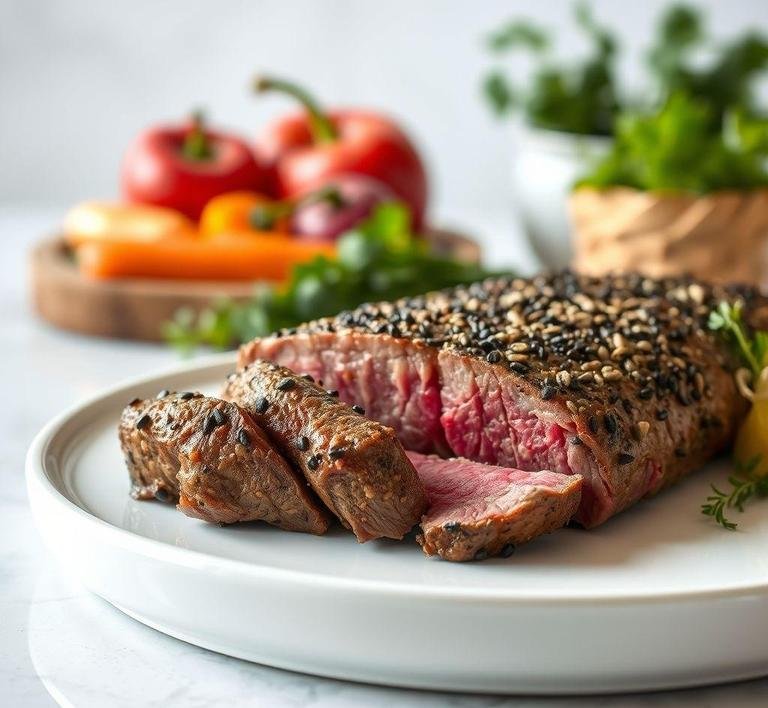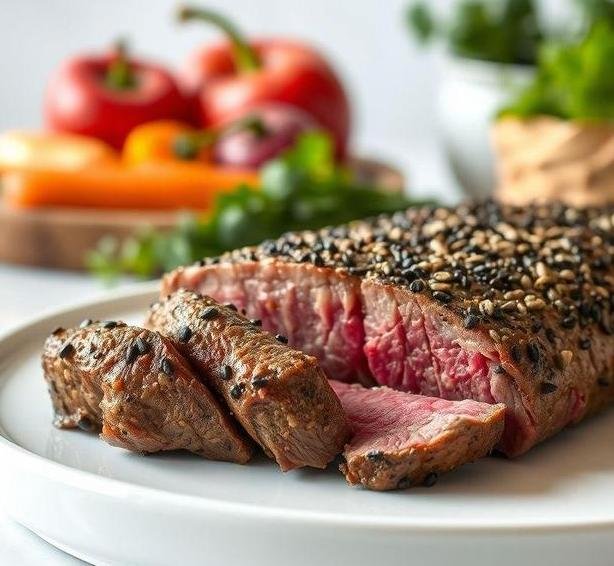Mary Berry’s Peppered Roast Beef Fillet is an exquisite and simple yet elegant dish that highlights the richness of a tender beef fillet coated in a robust, aromatic pepper crust. The famed British chef, Mary Berry, is celebrated for creating recipes that combine sophistication with accessibility, and this dish is a perfect example. The roast beef fillet is perfectly seasoned with a mixture of crushed black peppercorns, herbs, and mustard, which forms a flavorful outer crust that contrasts beautifully with the tender, succulent interior of the meat.
The fillet itself is one of the most prized cuts of beef due to its lean texture and delicate flavor, and Mary Berry’s recipe emphasizes these qualities, ensuring that the meat remains moist and flavorful during roasting. With a balance of bold seasoning and subtle heat from the peppercorns, the dish is both comforting and luxurious, making it suitable for special occasions, family gatherings, or any time you wish to indulge in a sumptuous, home-cooked meal.
This recipe not only showcases the beauty of beef fillet but also demonstrates the art of roasting meat to perfection, creating a golden, caramelized exterior while preserving the juiciness inside. Whether served with crispy potatoes, creamy mashed potatoes, or fresh vegetables, it’s a dish that elevates any dinner table.
Mary Berry’s Peppered Roast Beef Fillet Recipe
Ingredients Needed

To prepare Mary Berry’s Peppered Roast Beef Fillet, you will need a few key ingredients that work together to bring out the full flavors of the beef while ensuring it remains tender and juicy.
- Beef Fillet (1.5 – 2kg or 3 – 4 pounds): The centerpiece of this dish is the fillet itself, ideally one that has been trimmed of excess fat and sinew. This cut is tender, lean, and perfect for roasting.
- Black Peppercorns (2 tablespoons, freshly cracked): A generous amount of black peppercorns forms the heart of the seasoning for this dish. The peppercorns should be crushed coarsely to release their essential oils, which will give the roast a lovely aromatic and slightly spicy kick.
- Dijon Mustard (2 tablespoons): Mustard is used to bind the pepper crust to the meat, adding a tangy element that complements the richness of the beef. Dijon mustard is preferred for its mild heat and subtle flavor.
- Olive Oil (2 tablespoons): A small amount of olive oil helps in browning the fillet and ensures that the seasoning sticks to the surface of the beef.
- Garlic Cloves (2, minced): Fresh garlic is often used in roast beef recipes for its savory depth and slightly pungent flavor, which mellows during roasting.
- Fresh Thyme (1-2 sprigs, optional): A few sprigs of fresh thyme add a herby freshness that balances the heat of the peppercorns and complements the beef’s natural flavors.
- Salt (to taste): Essential for bringing out the natural flavors of the beef and balancing the pepper.
- Butter (2 tablespoons, optional for basting): While not necessary, a little butter can be melted over the beef during the roasting process to enhance its richness and provide a golden-brown finish.
Equipment Needed
The right equipment is crucial to ensure that the roast beef fillet turns out perfectly. Here is a list of the essential tools needed for this recipe:
- Roasting Tray: A sturdy roasting tray is necessary to cook the beef fillet evenly. Ideally, it should have a rack to elevate the beef off the base, allowing air to circulate around the fillet for even cooking.
- Meat Thermometer: A meat thermometer is your best friend when roasting meat, ensuring that the fillet is cooked to your preferred level of doneness (e.g., medium-rare, medium, well-done) without overcooking.
- Pestle and Mortar or Spice Grinder: For crushing the peppercorns. If you don’t have a pestle and mortar, you can use a spice grinder to achieve the same effect, though a mortar will allow for better control of the coarseness.
- Sharp Knife: For trimming the fillet and cutting it into slices after roasting. A sharp knife ensures clean, even slices without tearing the meat.
- Basting Brush: If you’re using butter for basting, a basting brush will help spread it evenly over the fillet.
- Cling Film or Foil: To wrap the fillet while it rests after roasting. This allows the juices to redistribute and ensures a moist, flavorful cut of meat.
Instructions To Make Mary Berry’s Peppered Roast Beef Fillet
- Preheat the Oven: Start by preheating your oven to 220°C (200°C fan)/425°F/Gas 7. A hot oven will help achieve the perfect sear on the roast beef fillet.
- Prepare the Fillet: Trim any excess fat or silverskin from the beef fillet with a sharp knife. Place the fillet on a board and rub it with the Dijon mustard. This will help the peppercorn crust adhere and impart a subtle tang.
- Crush the Peppercorns: Using a pestle and mortar or spice grinder, crush the black peppercorns until they are coarsely ground. You want large, visible chunks to create a thick, flavorful crust on the beef.
- Season the Beef: Generously coat the mustard-covered fillet with the crushed peppercorns. Sprinkle the beef with salt to taste, making sure the seasoning is evenly distributed.
- Sear the Beef: Heat the olive oil in a large frying pan over high heat. Once hot, add the fillet and sear it on all sides for about 2-3 minutes, until a golden-brown crust forms. This step locks in the juices and enhances the flavor of the beef.
- Roast the Beef: Transfer the seared fillet to a roasting tray and place it in the preheated oven. Roast for 20-25 minutes for medium-rare, or longer if you prefer your beef more well-done. For a more accurate result, use a meat thermometer – the internal temperature should be around 50°C (120°F) for rare, 55°C (130°F) for medium-rare, and 60°C (140°F) for medium.
- Rest the Beef: Remove the fillet from the oven and loosely cover it with foil. Let it rest for 10-15 minutes to allow the juices to redistribute and keep the meat tender.
- Serve: Once rested, carve the fillet into thick slices and serve with your choice of sides. The pepper crust should provide a wonderful contrast to the melt-in-your-mouth beef.
Tips And Tricks
- Choose the Right Cut: For the best results, use a high-quality beef fillet. Look for well-marbled meat, as this will result in a more flavorful and juicy roast. Opt for a butcher’s recommendation, especially if you’re cooking for a special occasion.
- Don’t Overcrowd the Roasting Tray: When placing the fillet in the roasting tray, make sure it’s not crowded. This ensures even heat circulation and prevents steaming, which can affect the texture of the roast.
- Allow the Beef to Come to Room Temperature: Before searing, allow the beef to come to room temperature for about 30-60 minutes. This ensures that the fillet cooks evenly.
- Resting is Key: Let the beef rest after roasting. This step is crucial as it allows the muscle fibers to relax and the juices to redistribute, making the meat more tender and juicy.
- Enhance the Crust: If you want an extra crunchy pepper crust, you can apply the crushed peppercorns and mustard, then let the beef sit in the refrigerator for 30 minutes to an hour before searing. This helps the crust adhere even better.
- Roast Vegetables Alongside: If you have the time, you can roast vegetables such as carrots, parsnips, and potatoes in the same tray. Just make sure they are cut into uniform sizes to ensure they cook evenly. This adds flavor to the entire dish.
Mary Berry’s Peppered Roast Beef Fillet is a show-stopping recipe that combines simplicity with elegance. With its rich, peppery crust and tender interior, it’s a guaranteed crowd-pleaser for any dinner party or special occasion. By using only a few carefully chosen ingredients, this dish lets the natural flavors of the beef shine through while adding just enough seasoning to make it truly memorable. Whether you’re an experienced cook or a beginner, this recipe allows you to create a luxurious meal that impresses without overwhelming your kitchen. So, gather your ingredients, follow the steps, and enjoy a slice of perfection that could only be brought to life by Mary Berry.
Easy Recipe Variations For Mary Berry’s Peppered Roast Beef Fillet

Mary Berry’s Peppered Roast Beef Fillet is a classic dish that brings elegance and flavor to any dinner table. The combination of succulent beef with the zing of cracked black pepper creates a bold yet refined taste. However, as with any timeless recipe, there is always room for creativity, especially if you’re looking to put your own spin on the dish. Here are several easy variations to elevate the flavors and adapt the dish to suit your preferences:
- Herb-Crusted Peppered Beef: Instead of just using cracked black pepper, consider mixing a variety of fresh herbs into the pepper crust. Thyme, rosemary, and oregano work wonderfully alongside the beef fillet, adding fragrant and earthy notes. Simply chop the herbs finely and mix them with the black pepper before applying them to the fillet. This will give the roast a fresh, garden-like aroma and an extra layer of flavor.
- Mustard and Pepper Crust: For a tangy twist, mix Dijon or wholegrain mustard with the pepper before rubbing it on the beef. The mustard will form a slight crust as the fillet roasts, adding a mild sharpness and depth of flavor. You could even combine the mustard with a little honey to balance out the acidity with a touch of sweetness.
- Spicy Peppercorn Roast: If you enjoy a bit of heat, experiment by adding different types of peppercorns to the crust. While black pepper is the traditional choice, using a blend of pink, green, and Sichuan peppercorns will provide varying degrees of heat and aromatic complexity. Crushed chili flakes or a pinch of cayenne pepper can also be added to enhance the spiciness.
- Bacon-Wrapped Roast Beef: For a smoky, savory variation, try wrapping the fillet in streaky bacon before roasting. The bacon not only adds a crunchy exterior but also infuses the beef with a rich, smoky flavor. The fat from the bacon will keep the beef moist during cooking, resulting in an incredibly tender roast.
- Garlic and Pepper Crust: For a bolder, more aromatic take, blend minced garlic with black pepper and a little olive oil to form a paste. Rub this paste over the fillet to infuse it with a deep garlic flavor that complements the peppery heat. You could even add a sprinkle of parmesan to the crust for an extra savory touch.
- Coffee-Crusted Roast Beef: For an unexpected but delicious twist, try using finely ground coffee beans in the crust along with the pepper. The coffee will create a deep, slightly smoky flavor that pairs beautifully with the richness of the beef. This variation works particularly well if you’re serving the roast with a dark, rich sauce, like a red wine reduction.
- Peppered Beef with Blue Cheese: After roasting the fillet, crumble some blue cheese on top while it’s still hot, allowing it to melt slightly over the beef. The creamy, tangy flavor of the blue cheese adds a luxurious, decadent element to the peppery roast beef, making it a perfect dish for special occasions or dinner parties.
These variations can be adjusted depending on what flavors you enjoy most, so feel free to experiment and make this dish your own. The key is balancing the boldness of the pepper with other ingredients that complement the tender beef fillet, allowing each element to shine.
Storing Leftovers
Once you’ve enjoyed the rich flavors of Mary Berry’s Peppered Roast Beef Fillet, the next step is knowing how to store leftovers properly so you can savor them later. Beef, especially when cooked to perfection, makes for fantastic leftovers, and with the right technique, you can maintain its flavor and texture for future meals.
- Allow the Beef to Cool Before Storing: Before putting any leftover beef in the fridge, allow it to cool to room temperature. This prevents condensation, which can lead to soggy meat and a loss of texture. However, do not leave the beef out for longer than two hours to ensure food safety.
- Wrap the Beef Properly: To keep the beef fresh, wrap it tightly in plastic wrap, wax paper, or foil. This will prevent it from absorbing other odors in the fridge. For an added layer of protection, you can place the wrapped beef in an airtight container or a resealable plastic bag to prevent moisture loss and preserve its juiciness.
- Refrigeration: Store the wrapped beef in the refrigerator for up to 3-4 days. After this period, the quality of the meat will begin to decline, and it’s best to either use it quickly or freeze it. Always check the beef for any signs of spoilage, like an off smell or change in texture, before consuming.
- Freezing Leftover Beef: If you don’t plan on eating the leftover beef within a few days, freezing it is a great option. Wrap the beef tightly in plastic wrap, then place it in a freezer bag or airtight container. To prevent freezer burn, squeeze out any excess air from the bag. Leftover roast beef can be frozen for up to 2-3 months.
- Reheating Leftovers: When reheating the beef, it’s essential to do so gently to avoid drying it out. The best method is to reheat it slowly in the oven. Preheat the oven to 300°F (150°C), and place the beef in an oven-safe dish. Add a splash of beef broth or water to the dish to create moisture. Cover with foil and heat for 15-20 minutes, or until the internal temperature reaches 130°F (54°C) for medium-rare.
Alternatively, you can slice the beef thinly and reheat it in a skillet over low heat with a bit of butter or oil to preserve its tenderness. If you’re pressed for time, a microwave can also do the trick, but be sure to use short bursts of heat and cover the beef to prevent it from drying out.
What To Eat With Mary Berry’s Peppered Roast Beef Fillet?
A peppered roast beef fillet is a hearty and flavorful dish, so pairing it with the right sides is crucial to create a balanced and satisfying meal. Here are some delicious options that will elevate your dining experience:
- Roast Potatoes: Classic roast potatoes are a perfect match for roast beef. The crispy exterior and soft, fluffy interior provide a wonderful texture contrast to the tender fillet. Toss them with rosemary, garlic, and olive oil before roasting to bring out extra flavor that complements the peppery beef.
- Yorkshire Pudding: No roast beef dinner is complete without Yorkshire puddings. Their light, airy texture and slightly crispy edges make them the ideal vessel for soaking up any gravy that accompanies the beef. These savory treats are a British tradition, and they add both flavor and fun to the meal.
- Creamed Spinach: For a rich, creamy side, serve Mary Berry’s Peppered Roast Beef Fillet with creamed spinach. The velvety spinach with its garlic and cream sauce creates a nice contrast to the spiced beef. The earthy flavor of the spinach also enhances the savory richness of the fillet.
- Gravy: A must-have accompaniment for roast beef, gravy will elevate the dish to new heights. You can make a simple red wine gravy using the pan drippings, or add a bit of balsamic vinegar for a tangy kick. If you’re feeling indulgent, a rich horseradish sauce would also complement the peppered beef perfectly.
- Green Beans Almondine: For a lighter, refreshing side, sauté green beans with butter, garlic, and toasted almonds. The crunchiness of the almonds and the delicate flavor of the beans create a balanced counterpoint to the rich beef.
- Cauliflower Cheese: If you want a dish that’s both comforting and indulgent, opt for cauliflower cheese. The creamy, cheesy sauce pairs beautifully with the beef, offering a richer alternative to traditional vegetable sides.
- Caramelized Shallots: The sweetness of caramelized shallots is a fantastic counterpoint to the peppered roast beef. They bring a hint of sweetness that enhances the beef’s savory flavor while adding a touch of elegance to your plate.
Conclusion
Mary Berry’s Peppered Roast Beef Fillet is a dish that exudes both sophistication and comfort. The juicy, tender beef paired with the bold pepper crust is undeniably delicious on its own, but as we’ve seen, there’s a wealth of creative variations to explore that can add even more excitement to the dish. Whether you opt for a herb-infused crust, a mustard tang, or a smoky bacon wrap, these variations offer something for every palate.
Storing leftovers is just as simple, with a few tips on wrapping, refrigerating, and reheating to ensure that the beef retains its flavor and texture. The dish’s versatility also extends to the sides that accompany it-whether you’re serving it with classic roast potatoes and Yorkshire pudding, or lightened up with creamed spinach and green beans, there’s no shortage of options that perfectly complement the rich, peppery beef.
Ultimately, Mary Berry’s Peppered Roast Beef Fillet remains a standout choice for any special occasion or weeknight dinner. Its bold flavors and versatility make it a meal that is sure to impress and satisfy anyone at the table, while leaving room for plenty of personalized twists and creative combinations.
FAQs
What Are The Key Ingredients Needed For Mary Berry’s Peppered Roast Beef Fillet Recipe?
To prepare Mary Berry’s peppered roast beef fillet, you will need the following key ingredients: a beef fillet (around 1.5kg), olive oil, black peppercorns (crushed), salt, Dijon mustard, garlic cloves, and fresh thyme. These ingredients are used to create the flavorful crust on the beef while ensuring it remains tender and juicy inside.
How Long Should I Roast The Beef Fillet For Mary Berry’s Peppered Roast Beef Fillet Recipe?
The roasting time for the peppered roast beef fillet depends on your desired level of doneness. For medium-rare, roast for about 45-50 minutes at 220°C (200°C fan-assisted) or 450°F. If you prefer it medium, aim for 55-60 minutes. Always use a meat thermometer to check that the internal temperature reaches 50-52°C for rare, 55-60°C for medium-rare, or 65°C for medium.
Can I Prepare Mary Berry’s Peppered Roast Beef Fillet In Advance?
Yes, you can prepare Mary Berry’s peppered roast beef fillet in advance. For the best results, you can season the beef with the crushed peppercorns, salt, Dijon mustard, and garlic mixture up to a day before roasting. Store it covered in the fridge, allowing the flavors to marinate. When you’re ready to roast, let the beef sit at room temperature for about 30 minutes before cooking to ensure even cooking throughout.


